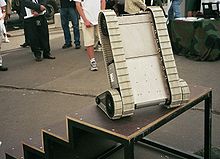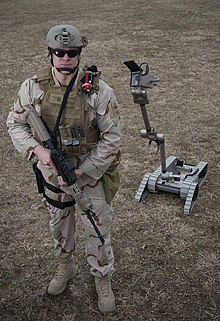PackBot
[3] Another instance of the PackBot technology being implemented was to the damaged Fukushima nuclear plant after the 2011 Tōhoku earthquake and tsunami where they were the first to assess the site.
February 2011 iRobot released confirmation of a deal totaling $4.4 million for the first quarter of 2011 for the manufacturing of 27 PackBot 510's and spare parts to accompany them.
The contract was priced at $9.6 million and includes the training of military personnel to operate the equipment, as well as lifetime repairs and technical support.
The robots were used for security purposes during the 2014 FIFA World Cup and the deal totaled $7.2 million in order to police the twelve host cities during the soccer matches.
NASA's Jet Propulsion Laboratory (JPL) is a facility responsible for the development of robotic space-crafts as well as the Deep Space Network.
Two PackBot rovers were deployed into the ruins of the nuclear power plant to assess damage, where the radioactivity was at high enough levels to prohibit humans from exploring.
The much-needed physical structure of the robots was designed by iRobot, while the instruments and science equipment on board was provided by NASA's Jet Propulsion Laboratory.
Additionally, the robot can communicate up to 1000 meters or 3281 feet, and captures information through four cameras with night vision, zoom, and illumination capabilities that allow for real time image processing.



